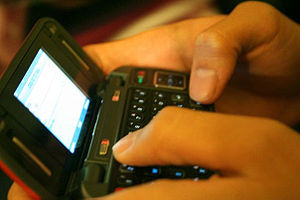
- Image via Wikipedia
Did you know that the average New Year’s resolution lasts 72 hours or less – about the same length of time a diet lasts? That means that on or about January 3, most people who made resolutions have forgotten or abandoned their plans for change. This year, I resolve to exceed the average (how hard can that be?) and keep my resolution of finding a healthy balance between personal sacred time and the constant demands of social media.
No matter who you are, it seems like time is the one thing we can’t get enough of. Whether you’re a student, a mother, a CEO, or Oprah, we all have the same amount of time: 24 hours in a day. Everyone seems to run into time constraints, no matter how efficient we are or how many gadgets we’ve purchased to help us stay “in tune” and “on track.” Now, thanks to the advancement of technology, most of us have the continuous demands of answering calls, text messages and e-mails, updating our Facebook and LinkedIn, and blogging or posting tweets. All of which seem to steal our valuable and irreplaceable personal time out from under us. How can we decide what to make a priority and what to let go for the sake of our own sanity?
But first, it’s time for me to be completely honest. I’m addicted to texting and e-mail, which is why I’ve made it my New Year’s resolution to end my ongoing battle of being constantly connected. I text all the time, and I have to respond to my texts the moment I hear my phone vibrate. I’ve even written books about mobile messaging, and all the amazing things (and not so amazing) that technology offers… who does that? When it comes to e-mail, I need to read them the second they arrive. Does my constant need to check my iPhone interrupt my personal time? Absolutely! Does it drive my husband crazy when I check my phone on Sunday mornings? He can’t stand it, and he’s the first person to tell me that I need therapy, if such a program exists.
One thing’s for sure. The demands of being constantly connected are never ending, and IF we don’t stop to smell the roses and start to “live in the moment,” we might all need to stage an intervention and check our loved ones (or ourselves) into Connective Addictive Therapy.
How can we take back our personal time? Do you remember the moment you lost it in the first place? For me, it started about five years ago when I got my first BlackBerry. In the snap of a finger, I could instantly get my e-mail, text messages and access the Internet – even when I was away from my office. I felt like I had died and gone to heaven! But after five plus years of being connected 24/7, I often feel like I’ve gone in the opposite direction.
So, I’ve done what most of us do during this time of year. I’ve examined my shortcomings and made it my New Year’s resolution to face my connective addiction. I’ve decided to send myself into social media rehab, and enter into the 5-step program that I’ve developed for people like me. If you feel like you are overly connected and ready to take back the time that you’ve stolen from yourself, here’s how the program works:
1. Put away your cell phone while you are with others, at work or driving (I keep mine in my handbag so it’s completely out of sight)
2. Look at your phone no more than five times a day (unless you’re expecting an important call or a message) Once you’ve answered your messages, return it back to where it was.
3. Limit your social networking time to no more than two sites, and to the amount of time that is right for your personal and professional objectives.
4. On weekends and vacation time, limit your “constant connectivity” to urgencies and emergencies, so you can really enjoy the ones you choose to spend your personal time with. And don’t forget about “me” time.
5. Schedule more quality time away from technology driven activities.
We all know it’s impossible (and unhealthy) to spend all of our time staring at our cell phones, iPads and computers AND preserve a healthy balance with our personal sacred time. Yes, 2011 is upon us, so get with setting realistic goals, work hard to achieve them, and realize those changes you desire. This may sound like a difficult undertaking, but if it was easy, we wouldn’t have this problem to begin with AND I wouldn’t be writing this blog.
Shawn Edgington is America’s leading “Texpert”, cyberbullying expert and the CEO of a National Insurance firm. She’s the author of Read Between the Lines and The Parent’s Guide to Texting, Facebook and Social Media, slated for release in January 2011. Shawn’s been profiled on Fox Business, Fox News Radio, in the San Francisco Chronicle, View from the Bay, NPR, CBS Radio, and dozens of media outlets around the country. Visit her at: www.digitalworld101.com.





